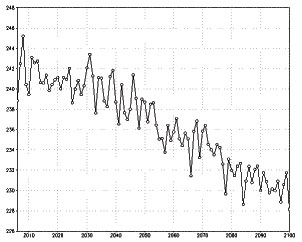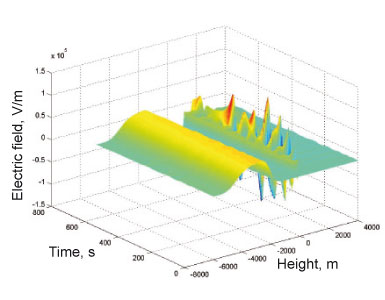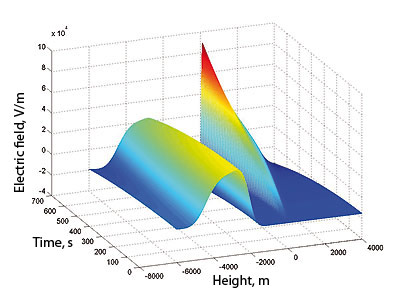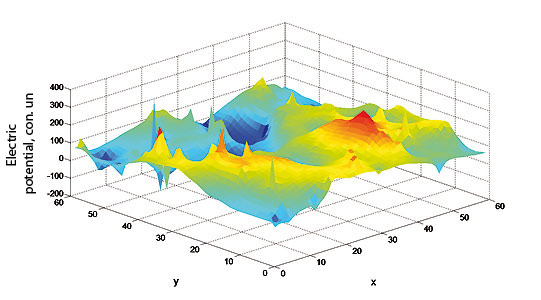This interdisciplinary field combines full-scale experiments, laboratory simulations, and theoretical studies connected with the study of fundamental problems of electrodynamics of the atmosphere and near space. A general and relatively new problem of geophysical electrodynamics is the problem of electric dynamo, i.e., the generation of a large-scale electric field in a weakly conducting medium, including disperse multi-phase media, in dust and aerosol plasma allowing for turbulence. Great interest has been recently sparked by the studies of interaction of geospheric sheaths and dynamics of atmospheric electricity under the conditions of changing climate. In the entire world, special attention is given to the problems of formation of the global electric circuit in the atmospheres of the Earth and other planets of the Solar system, as well as finding out the connection of electric phenomena with peculiarities of solar activity, radiation regimes, general circulation, and the hydrologic cycle of planets.
At IAP, development of this field was initiated by the works by V. Yu. Trakhtenhertz, Yu. V. Chugunov,
P. A. Bespalov, A. V. Kostrov, S. V. Golubev. Currently, this field is explored intensely, first of all, in the department of the geophysical electrodynamics and the group of ionospheric and magnetospheric plasma. During the past decade IAP researchers (E. A. Mareev, D. I. Iudin, Yu. V. Shlyugaev, V. V. Klimenko, S. S. Davydenko,
A. V. Kalinin, N. A. Bogatov, et al.) in the wide-range framework of cooperation with other Russian and foreign scientific groups obtained many new results.
- Parametrization of the basic generators of the global electric circuit, i.e., quasistationary currents of electrically active clouds, have been obtained for the first time and included in the high-resolution climate model (jointly with the Institute of Computational Modelling of the Russian Academy of Sciences). Model calculations of the ionospheric potential for the instrumental-measurement epoch have demonstrated daily and seasonal variability, which agree well with observations. It has been shown that as global warming develops following typical scenarios of the increase in the content of greenhouse gases in the atmosphere, the ionospheric potential should decrease with a decrease in the convection area in the tropics.

Evolution of the ionospheric potential in the XXI century
for the scenario of the increase in the greenhouse content RCP 8.5
- The dynamics of slow transient currents in lightning flares and the role of such currents in the global electric circuit have been studied; the efficiency of the "cloud-to-ground" flares as current sources in the global circuit depend significantly on the height of the charge location in the conducting atmosphere and varies from 15% to 90% in the height range from 1 km to 14 km above ground. The obtained results have been confirmed by full-scale field measurements of the slow component of the electric field.
 |
 |
Dynamics of the electric field near the melting band for two different parameters of the problem |
- The method of detecting the global frequency of the "cloud-to-ground" storm discharges basing on the statistic characteristics of the natural electromagnetic noise in the 1—30 GHz frequency band has been proposed and tested. The estimated frequency of the "cloud-to-ground" discharges (10—30 s—1) is 3—5 times lower than the characteristic frequency of the optical flares detected by satellites and agrees with the known average ratio of the frequencies of the "cloud-to-ground" and intracloud discharges. Time-sequential activation of storm centers is accompanied by an increase in the discharge frequency, rather than in their average power. The proposed method allows one to promptly measure the qualitative characteristics of lightning activities in the global current circuit and estimate its response to external actions, such as the Forbush decrease in the flow of space rays during
solar flares.

Potential Brown relief of a model storm cloud
- Short-period pulsations of the electric field, current, and spatio-temporal structures in the boundary layer of the atmosphere have been studied extensively in cooperation with the Geophysical Observatory "Borok" of the RAS Institute of Physics of the Earth. Regularities of formation and evolution of aeroelectric structures in the near-Earth layer have been studied under the conditions of good weather and fog. The frequency of formation of aeroelectric structures in the boundary layer is a qualitative indicator of the intensity of the initial convection stage, which allows one to use simple remote measurements to perfect the processes of prediction and studying of convective clouds in the atmosphere.
- Basing on the results of the ground-based and balloon measurements, a model of distribution of the electric field and current in the vicinity of high-power storm complexes, i.e., mesoscale convective systems with horizontal dimensions from tens to hundreds of kilometers, has been developed. The contribution of such systems to the global electric circuit exceeds the contribution of isolated storms by more than ten times and, depending on the internal structure of a complex, can lead to both the maintenance and relaxation of the ionospheric potential.
- The theory for generation of intense layers of the positive charge in the lower part of nimbostratus clouds and mesoscale convective systems, which is due to electrostatic charging of ice particles during their melting near the zero isotherm, has been developed. A considerable contribution of these layers to the quasistationary current of the global atmospheric circuit has been detected, as well as variations of these contribution with periods from fractions of seconds to tens of seconds.
- The models of initiation of discharges (sprites and haloes) in the middle atmosphere and plasmochemical models for description of the influence of sprites and haloes on the ionization level and composition of the lower ionosphere have been developed.
- Laboratory simulation of the spectral of electrogasdynamic (EGD) turbulence of a convective cloud in a weakly ionized aerosol medium has been performed. It is proposed to use the method of measuring the EGD turbulence spectra for diagnostics of compact strong-field regions in storm clouds, which is necessary to study the problem of lightning ionization.
- The mechanism of discharge initiation in a d.c. electric field has been studied by using a plasma channel produced in air by a high-power femtosecond laser pulse with the purpose of development of an effective laser method of controlling lightning discharges.
Some of the latest achievements in the field of near-space electrodynamics are connected with a fast advance in the satellite- and rocket-based experiments. However, laboratory simulations are still an important and even indispensable tool for studying many various problems. The range of these problems, specifically, include the studies of physical processes, which develop during excitation, propagation, and interaction of intense electromagnetic radiation with magnetized plasma, the effects of generation of d.c. currents and magnetic fields, and formation of self-consistent plasma-field structures. The laboratory experiments are most useful when researchers study the effects of active modification of the ionospheric and magnetospheric plasma including a most complicated set of the phenomena, which develop when the ionosphere is heated with high-power radio emission of the short-wave band. Interesting results have been obtained by using the plasma stands "Krot" and "Ionosphera" (A. V. Kostrov, A. V. Strikovskiy, M. E. Gushchin, M. V. Starodubtsev et al.):
| |
|
| |
"Ionosphera" stand: overall view
|
- The experiments performed on the large-scale plasma stand "Krot" revealed an effect of generation of a quasistationary magnetic field in weakly collisional magnetoplasma in a spatially inhomogeneous high-frequency field of the whistler frequency range. This effect can be observed in active experiments performed in the upper ionosphere and magnetosphere of the Earth, specifically, the experiments employing high-power VLF transmitters onboard satellites and rockets. Such effects should be allowed for when planning for active experiments. In the case of periodic modulations of the high-frequency pumping, the phenomena of generation of quasistationary magnetic fields can be used to excite whistler and Alfvén waves.
- Basing on the results of model laboratory experiments, which were performed on the "Krot" stand, a new method was proposed for parametric generation of low-frequency waves by magnetoplasma electrons accelerated in the near field of a spacecraft antenna under the conditions of electron-cyclotron resonance.
- It has been shown that amplitude modulations of the signal fed to the antenna results in emission of waves having the frequency of modulation to the surrounding plasma; in this case, an extended region of the plasma with accelerated electrons acts as a parametric "bodiless" antenna. Noncontact measurements of plasma density and the electron collision rate in an atmospheric-pressure discharge were performed for the first time using the method of near-field microwave diagnostics. The proposed method can be used to diagnose plasma parameters under space conditions.
- It was shown during laboratory simulation of the processes, which led to formation of the spectra of artificial radio emission of the ionosphere (AREI), and in active experiments on modification of the ionospheric plasma with high-power short-wave radio emission of ground-based transmitters that the structures similar to the main spectral maximum of AREI can be observed in the process of thermal self-channeling of Langmuir waves in extended small-scale plasma inhomogeneities. The proposed model was used to explain the mechanisms of generation of a new AREI component found during heating experiments on the "Sura" stand.





